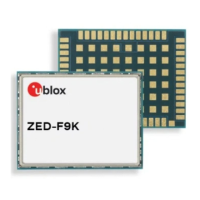

Do you have a question about the Ublox ZED-F9K and is the answer not in the manual?
| Brand | Ublox |
|---|---|
| Model | ZED-F9K |
| Category | Control Unit |
| Language | English |
Introduces the ZED-F9K module, its capabilities, and applications in automotive markets.
Explains ADR technology for high-accuracy positioning in areas with poor or no GNSS coverage.
Describes low-latency position output using sensor data for time-critical applications.
Details the configuration of the ZED-F9K using UBX configuration interface keys.
Details the RTCM binary data protocol for GNSS correction information.
Covers configuration options for the navigation engine, including platform settings.
Introduces ADR for high-accuracy positioning in poor/no GNSS coverage areas.
Details configuring IMU-mount misalignment angles for accurate sensor fusion.
Describes the multi-protocol communication interfaces: UART, SPI, I2C, USB.
Details the antenna supervisor for checking antenna circuits and detecting faults.
Introduces concepts of receiver clocks, time bases, and timestamps.
Covers the security concept for the receiver and air interface.
Details the pin assignments of the ZED-F9K module and their functions.
Covers the module's power supply requirements and voltage considerations.
Discusses requirements for active antennas for good performance.
Covers precautions for Electrostatic Discharge and Electrical Overstress.
Details layout and placement requirements for optimal GNSS performance.
Provides general design guidance and checks for successful integration.
Checks RF input requirements and schematic considerations.
Details precautions for handling Electrostatic Sensitive Devices.
Covers soldering paste, reflow soldering, rework, and conformal coating.
Provides a list of abbreviations and their definitions used in the manual.
Guides on evaluating ZED-F9K RTK operation using u-center software.